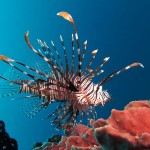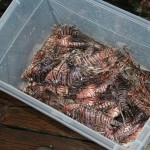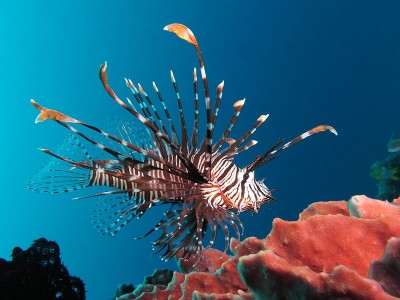 Native to reefs in the Indo-Pacific region, the lionfish is a member of the scorpion fish family. Growing upwards of 45 cm in length and 1.3 kg in weight, it is an aggressive, territorial species with very few predators likely due to the fact that they are venomous. Large spins located within the dorsal, anal, and pectoral fins are capable of delivering a mix of the neurotransmitter acetylcholine and a neuromuscular toxin causing pain, swelling, respiratory distress, and, in some cases, paralysis. With a life span of 5-15 years, chemical arsenal, and a ferocious appetite, this is one species that knows how to survive.
Native to reefs in the Indo-Pacific region, the lionfish is a member of the scorpion fish family. Growing upwards of 45 cm in length and 1.3 kg in weight, it is an aggressive, territorial species with very few predators likely due to the fact that they are venomous. Large spins located within the dorsal, anal, and pectoral fins are capable of delivering a mix of the neurotransmitter acetylcholine and a neuromuscular toxin causing pain, swelling, respiratory distress, and, in some cases, paralysis. With a life span of 5-15 years, chemical arsenal, and a ferocious appetite, this is one species that knows how to survive.
In the mid-1990s, two of the recognized ten species of lionfish, Pterosis volitans and Pterosis miles, became popular display specimens for aquarium enthusiasts. In part because of their unique red and brown pattern and radially displayed fins, lionfish are quite spectacular to see. While on display they proved to be active and some may even say aesthetically pleasing to watch. However, lionfish tend to not play well with others. In fact, they will usually eat all other cohabitants, a costly problem. It is assumed that because of the danger to owner and aquatic neighbor, a large number of lionfish were simply returned whence they came . . . or so owners thought. After all, the ocean is the ocean, right? It is known that in 1992 the wrath of Hurricane Andrew released 6 lionfish in costal waters around Florida. However, the first documented lionfish was found as early as 1985 in nonnative waters of the Atlantic Coast of the US. These data suggest irresponsible owners discarding unwanted fish in nonnative waters have been the catalyst to a recent ecological problem.
display specimens for aquarium enthusiasts. In part because of their unique red and brown pattern and radially displayed fins, lionfish are quite spectacular to see. While on display they proved to be active and some may even say aesthetically pleasing to watch. However, lionfish tend to not play well with others. In fact, they will usually eat all other cohabitants, a costly problem. It is assumed that because of the danger to owner and aquatic neighbor, a large number of lionfish were simply returned whence they came . . . or so owners thought. After all, the ocean is the ocean, right? It is known that in 1992 the wrath of Hurricane Andrew released 6 lionfish in costal waters around Florida. However, the first documented lionfish was found as early as 1985 in nonnative waters of the Atlantic Coast of the US. These data suggest irresponsible owners discarding unwanted fish in nonnative waters have been the catalyst to a recent ecological problem.
 In 1999, divers near Miami commonly saw P. voitans and P. miles. In less than 10 years large numbers were observed throughout Jamaica and the Bahamas, as far south as Cuba and as far north as Delaware and New Jersey. By 2012, lionfish were dominating reefs and wrecks off the coasts of Guatemala, Panama, Costa Rica, Venezuela, and the Gulf of Mexico. At present time, in this divers personal experience, it is hard pressed not to see at least one lionfish on every dive. As documented in a recent trip report, of four dive sites within the Flower Garden Banks National Marine Sanctuary in the Gulf of Mexico, lionfish were observed at all but one.
In 1999, divers near Miami commonly saw P. voitans and P. miles. In less than 10 years large numbers were observed throughout Jamaica and the Bahamas, as far south as Cuba and as far north as Delaware and New Jersey. By 2012, lionfish were dominating reefs and wrecks off the coasts of Guatemala, Panama, Costa Rica, Venezuela, and the Gulf of Mexico. At present time, in this divers personal experience, it is hard pressed not to see at least one lionfish on every dive. As documented in a recent trip report, of four dive sites within the Flower Garden Banks National Marine Sanctuary in the Gulf of Mexico, lionfish were observed at all but one.
With the vastness of the ocean, why should we care that such a small fish seems to be thriving in nonnative waters? Lionfish are long lived and are very reproductively successful; every spawning event has the potential to add 30,000 individuals to the population. Armed with venom, these species have very few predators. Species of large grouper are known to inhabit both native and nonnative water; however, the grouper has been so overfished their current existence is in question. Being veracious predators themselves, lionfish simply displace other species or eat them. A recent study of stomach contents of lionfish in the Gulf of Mexico found no less than four species of smaller fish, several invertebrates, and mollusks in a single individual. In short, they eat everything. Lionfish appear to be both temperature and salinity tolerant, suggesting they can live quite comfortably in the ocean as well as estuaries and freshwater. Together with pelagic larval distribution, population densities have reached orders of magnitude greater than those in native ranges. The presence of the lionfish has the potential to disturb the trophic cascade of delicate marine ecosystems. Within native habitat predators would keep numbers manageable by targeting larvae and juveniles. At present, it appears that the lionfish is starting to take over.
Eradication of lionfish in order to protect our fragile marine ecosystems within coastal water is key. But, with few  natural predators, how do we target a single species without harming others? Recently, lionfish round-ups and fishing derbies are helping jump start the removal of this pest. Some competitions have witnessed a one-day take of over 500 lionfish! Opening a year-round season on spearfishing has been introduced in Florida with great success. Restaurateurs within the Caribbean have also been doing their part by putting lionfish on the menu. In a recent Huffington Post article, lionfish has a distinct flavor that could catch on as a delicacy.
natural predators, how do we target a single species without harming others? Recently, lionfish round-ups and fishing derbies are helping jump start the removal of this pest. Some competitions have witnessed a one-day take of over 500 lionfish! Opening a year-round season on spearfishing has been introduced in Florida with great success. Restaurateurs within the Caribbean have also been doing their part by putting lionfish on the menu. In a recent Huffington Post article, lionfish has a distinct flavor that could catch on as a delicacy.
The story of the lionfish is sadly one of many examples of how irresponsible pet ownership has lead to a compromise of native species and their habitat. More than ninety-five percent of our oceans are yet to be explored. We have the chance to understand our planet on a new level as we learn the secrets of this underwater world. It would be devastating if the act of stupidity by a few lead to the devastation of such a miraculous place before we even catch so much as a glimpse.
